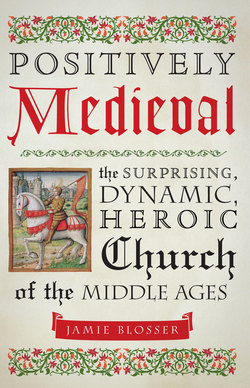Читать книгу Positively Medieval - Jamie Blosser - Страница 6
На сайте Литреса книга снята с продажи.
ОглавлениеPreface
When I went off to college at the age of eighteen, I hadn’t put much thought into what medieval Christianity was like, but in the back of my mind were images of dirty, sickly people living in mud huts and worshiping statues of Mary, opulently dressed churchmen hawking relics and indulgences, and sneering Inquisitors burning witches and Protestants. I’m not sure who, exactly, was responsible for putting these images into my head, but I’m pretty sure it was a collective effort.
I was a Protestant, though not a very good one, and that probably had something to do with it, although I don’t remember my parents or pastors talking like this. It was more of an unstated historical dogma of American Protestantism: Martin Luther had restored authentic, Bible-believing, Jesus-centered, morally pure Christianity in 1517, and all that had gone before was superstitious, insincere, and morally corrupt.
My enrollment as a religious studies major in college, and the Church history courses I took subsequently, dealt a serious blow to this assumption. As it turns out, I found a good deal of authentic, Bible-believing, Jesus-centered, morally pure Christianity in the 1,400 years between the apostles and Martin Luther. I devoured the books I was given: St. Thomas Aquinas’ Summa, St. Benedict’s Rule, the lives of St. Francis, the Imitation of Christ, St. Bernard’s commentaries, and all the rest. When I converted to Catholicism two years later, it wasn’t so much that I renounced the religion in which I had been raised. Rather, I had found it all over again, but in a purer, richer, and more abundant form than I had ever known existed.
Even up to the dawn of the Reformation itself, medieval Christians had shown an encyclopedic knowledge of the Bible that would have put my Sunday School teachers to shame. Their writings evidenced a heartfelt, personal love for Jesus and His cross that made my own faith seem tepid in comparison; thousands of them had devoted their lives, and even given them up in martyrdom, to plant the seeds of the Gospel throughout the world. These were the values that my parents and pastors had taught me to love and cherish: How could I resist?
Even more, as my academic studies advanced, I found that many of my personal efforts at theological reflection had been spent, as it were, reinventing the wheel. After countless hours spent trying to produce (very bad) arguments for God’s existence for my atheist friends, I discovered the brilliant ones written by Aquinas and Anselm. After spending as many hours puzzling out the meaning of obscure passages of Scripture, I picked up the commentaries of Augustine and Origen and the difficulties vanished. My reaction was very nearly one of betrayal. All these years, this vast storehouse of Christian wisdom had been right under my nose, and no one had told me about it?
My historical assumptions had been all wrong. In every generation—including the Middle Ages—faithful Christians had passed on the torch of the Christian faith, keeping the flame alive even in the most difficult moments. The Reformation had not rediscovered an authentic Christianity long since vanished from the earth: that authentic Christianity had been there all along. Now, I have no misty-eyed nostalgia for the medieval Church, which was just as sin-infected and scandal-ridden as the Church in our own day. Nor do I have any personal disdain for the Protestant Reformers, who in many ways were doing their best to address the legitimate problems of medieval Christianity, even if (in my own view) their radical solutions ended up ripping out the very foundations of the medieval Church they were trying to reform.
So why is it worth giving medieval Christianity a second look? The momentous events of the early modern era—the Reformation, the Renaissance, the discoveries of the New World, the Enlightenment, and the Scientific Revolution—so completely reworked Western civilization as to remove almost every vestige of medieval Christianity. And the gifts of the modern age are innumerable: technological innovation, economic prosperity, widespread literacy, and a thousand other undeniably beneficial developments.
Yet underneath this new superstructure, modern civilization has always been fueled by an unstated set of humane moral values such as a belief in human dignity and a broad sense of what counted as good and bad human conduct; a general (if vague) recognition of a divine Creator and a respect for the integrity of His creation; a deeply felt desire for justice and fair play; and the need to make personal sacrifices for the common good.
These values, however, were not modern inventions. They were not invented by the Protestants or the Enlightenment philosophers. Inasmuch as they are part of the Gospel message itself, they were the legacy of medieval Christianity, carefully and heroically preserved and transmitted to the modern world by medieval Christians, often at great cost.
Yet many observers have noted that these very beliefs and values, in the last half century or so, seem to be drying up, and the social and institutional structures of medieval Christendom which once sustained them no longer exist, or at least no longer have the cultural influence they once had.
Medieval Christendom can’t be rebuilt, and probably shouldn’t be even if it could. But the timeless values and beliefs that lay at the heart of medieval Christianity must be rediscovered, sustained, and preserved, if modern society itself is to be preserved.
